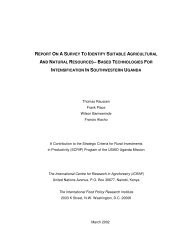Continuities in environmental narratives, Kabale, Uganda ... - Foodnet
Continuities in environmental narratives, Kabale, Uganda ... - Foodnet
Continuities in environmental narratives, Kabale, Uganda ... - Foodnet
You also want an ePaper? Increase the reach of your titles
YUMPU automatically turns print PDFs into web optimized ePapers that Google loves.
Permanent cultivation, with short rotation periods, prevails [<strong>in</strong> this region]. …Soil<br />
deterioration and crop yields decl<strong>in</strong>e are a common consequence of such farm<strong>in</strong>g<br />
practices… The susta<strong>in</strong>ability … [of the <strong>Kabale</strong> system of agriculture] is seriously<br />
threatened by the rapid decl<strong>in</strong>e <strong>in</strong> soil fertility. . . The reduction <strong>in</strong> farm size long ago<br />
resulted <strong>in</strong> the abandonment of fallow<strong>in</strong>g practices and cont<strong>in</strong>uous cultivation is now<br />
common <strong>in</strong> the area. 61<br />
It is not only outside agencies who adopt this <strong>environmental</strong> narrative. Today’s DAO<br />
observes that ‘fields are cropped every season without a rest’ 62 and accord<strong>in</strong>g to the <strong>Kabale</strong><br />
District Agricultural Work Plan for 1996 one of the major problems for the district are that, due<br />
to ‘population pressure on land, land is over cultivated with short rotation. Most soils are<br />
degraded and exhausted result<strong>in</strong>g <strong>in</strong> low productivity.’ 63 The District Environment Profile<br />
records<br />
The high population density and the nature of the terra<strong>in</strong> <strong>in</strong> <strong>Kabale</strong> district have led to<br />
excessive soil erosion. There is cont<strong>in</strong>uous cultivation of land without rest lead<strong>in</strong>g to soil<br />
degradation and exhaustion thus soils have low values of <strong>in</strong>filtration and soil water<br />
retention capacity. The end result of this has been highly leached soils that have<br />
consequently lost fertility. All these problems have been aggravated by land<br />
fragmentation and <strong>in</strong>adequate soil conservation measures such as terrac<strong>in</strong>g, mulch<strong>in</strong>g,<br />
contour strip plant<strong>in</strong>g, especially on hillslopes. 64<br />
Aga<strong>in</strong>, the negative role of people is observed: ‘soil erosion has also largely been accelerated by<br />
human activities. The district experiences cont<strong>in</strong>uous cropp<strong>in</strong>g of land without amply rest and<br />
…cont<strong>in</strong>uous cropp<strong>in</strong>g is carried out without appropriate soil and water conservation<br />
measures.’ 65<br />
In the immediate post-Independence period the rhetoric around <strong>environmental</strong><br />
susta<strong>in</strong>ability with<strong>in</strong> government at a national level changed little. Although much legislation<br />
was revised <strong>in</strong> 1964, this was more ‘<strong>in</strong> form than <strong>in</strong> substance.’ 66 Thus at a district level<br />
Government policy around environment cont<strong>in</strong>ued more or less unchanged <strong>in</strong> the immediate<br />
post-Independence period. There was a cont<strong>in</strong>ued focus on soil conservation, which was<br />
implemented through both agricultural extension workers and local chiefs, and the policy of<br />
swamp reclamation also cont<strong>in</strong>ued. There was, however, no more organised resettlement.<br />
In more recent years concerns over the environment have become more explicit at a<br />
national level, with, for example, the creation of the National Environmental Management<br />
Authority (NEMA) as the umbrella agency <strong>in</strong> <strong>environmental</strong> management. This is the pr<strong>in</strong>cipal<br />
61 Agroforestry Research Networks for Africa <strong>Uganda</strong> National Taskforce (AFRENA). Agroforestry potentials for<br />
the land-use systems <strong>in</strong> the bimodal highlands of eastern Africa: <strong>Uganda</strong>. AFRENA Report No. 4. International<br />
Centre for Research on Agroforestry. (Nairobi, 1992).<br />
62 Interview with Sunday Mutabazi, District Agricultural Officer, February 1996.<br />
63 <strong>Kabale</strong> District, Department of Agriculture, 1996.<br />
64 <strong>Uganda</strong> Government, <strong>Kabale</strong> District Environment Profile (National Environment Information Centre, Kampala,<br />
1995), 43.<br />
65 <strong>Uganda</strong> Government, <strong>Kabale</strong> District Environment Profile (National Environment Information Centre, Kampala,<br />
1995), 66.<br />
66 G.W. Tumushabe, ‘Environmental governance, political change and constitutional development <strong>in</strong> <strong>Uganda</strong>’, <strong>in</strong><br />
H.W. O. Okoth-Ogendo and G.W. Tumushabe (eds) Govern<strong>in</strong>g the Environment: Political Change and Natural<br />
Resources Management <strong>in</strong> Eastern and Southern Africa (ACTS, Nairobi, 1999), 69.<br />
D:\_<strong>Uganda</strong> Land Use\SW land use and soils\Carswell papers\Carswell- Narratives paper-17 Dec.doc<br />
11
















